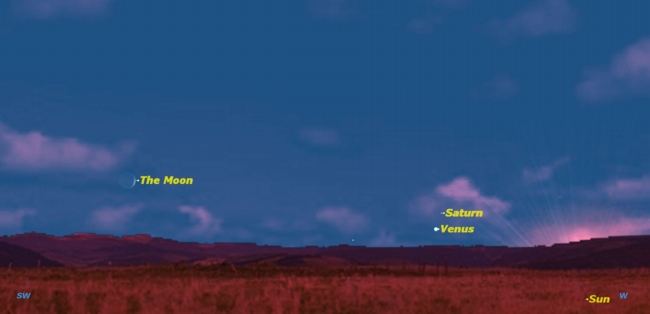See Planets Saturn & Venus Perform Celestial Dance Tonight

Take a look at the western horizon just after sunset tonight (Sept. 29) and you may be able to see two planets in close conjunction, and a skinny 3-day-old moon.
The planet Venus has been on the far side of the sun for the last few weeks and is just now making its appearance in the western sky as an "evening star."
Thursday night it will pass less than three moon-widths from Saturn, which is about to disappear behind the sun. The two planets appear to be moving in opposite directions because of the movement of a third planet: the Earth, from which we observe them. [Gallery: The Rings and Moons of Saturn]
The sky map of Venus and Saturn here shows how they will appear in the night sky tonight.
Venus is, of course, a planet and not a star, but it was named "evening star" and "morning star" long before we knew the difference between stars and planets. Stars shine with their own light, while planets only reflect the sun's light.
Seeing these two planets will be a challenge, and a set of binoculars may come in handy.
Find an observing location with a low western horizon and wait until just after the sun sets. Then sweep across the horizon to the left of the sun to spot the thin sliver of the lunar crescent. Look for the ghostly Earth-lit portion of the moon to the left of the sunlit crescent.
Get the Space.com Newsletter
Breaking space news, the latest updates on rocket launches, skywatching events and more!
Now sweep back toward the sunset point, keeping an eye out for brilliant Venus. It will be extremely low and close to the horizon. Just above it you should see a tiny pinprick of light, which is the distant giant planet Saturn.
Saturn will be gone from sight behind the sun for the next month, reappearing in the dawn twilight early in November.
Venus, on the other hand, is just beginning its evening appearances. It will dominate the western sky just after sunset all winter and well into spring, heading toward its transit across the face of the sun on June 5.
This is a good time to check up on the other planets.
Brilliant Jupiter is rising just before 9 p.m., heading toward opposition on Oct. 29. Mars rises around 2 a.m. and is gradually brightening on its way to opposition on March 3, 2012. Uranus passed opposition on Monday, making it well-placed for evening observation with binoculars or a small telescope. Neptune is five weeks past opposition and also well-placed in the evening sky.
The only planet not currently visible is tiny Mercury, too close to the sun to be seen until it reappears as an "evening star" next month.
This article was provided to SPACE.com by Starry Night Education, the leader in space science curriculum solutions. Follow Starry Night on Twitter @StarryNightEdu.
Join our Space Forums to keep talking space on the latest missions, night sky and more! And if you have a news tip, correction or comment, let us know at: community@space.com.

Geoff Gaherty was Space.com's Night Sky columnist and in partnership with Starry Night software and a dedicated amateur astronomer who sought to share the wonders of the night sky with the world. Based in Canada, Geoff studied mathematics and physics at McGill University and earned a Ph.D. in anthropology from the University of Toronto, all while pursuing a passion for the night sky and serving as an astronomy communicator. He credited a partial solar eclipse observed in 1946 (at age 5) and his 1957 sighting of the Comet Arend-Roland as a teenager for sparking his interest in amateur astronomy. In 2008, Geoff won the Chant Medal from the Royal Astronomical Society of Canada, an award given to a Canadian amateur astronomer in recognition of their lifetime achievements. Sadly, Geoff passed away July 7, 2016 due to complications from a kidney transplant, but his legacy continues at Starry Night.









